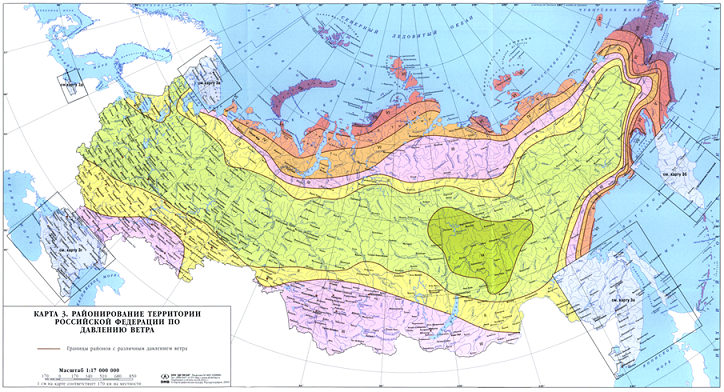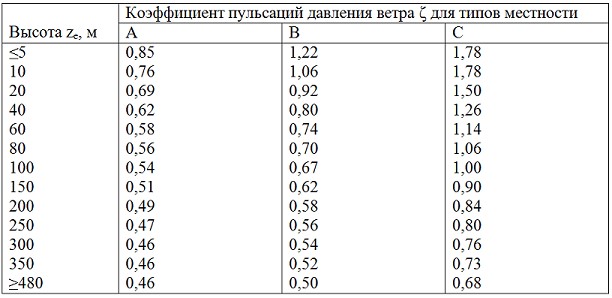Selection of an external lightning protection system in accordance with the requirements of modern Russian standards, including wind load on the air terminal mast.
The material of the article is intended to assist the project designer in the selection of lightning protection products that meet the Russian standards and norms. Basic requirements for the cross-section and the material of air terminals and down conductors are studied in its first part. The second part is devoted to normalization of wind impact to air terminal masts. Lightning rods is considered to correspond to the relevant Russian standards, if it is tested for wind pressure equal or greater than the normative one. The article gives the algorithm for calculating normative wind pressure. However, different producers provide information about the resistance of their masts to wind influences in different ways (indicate wind zone, wind speed ...). The final part of the article focuses on how to use this information to get the value of wind pressure which the tested mast can stand.
Excessive variety of lightning protection products of various foreign manufacturers is presented on the modern market. Suppliers proudly claim that the products they offer are manufactured according to the latest technologies of high quality raw materials and meets the latest foreign standards of quality and reliability. Sometimes it is not easy for the project designer to understand how these standards relate to the Russian ones.
First of all, let's divide the requirements of Russian norms and standards in the area of lightning protection into two categories:
- Requirements of AD 34.21.122-87 "Directions for lightning protection of buildings and structures" and IS 153-34.21.122-2003 "Directions for lightning protection of buildings, structures and industrial communications"
These documents mainly impose requirements to the material and the cross sectional area of lightning protection products intended to drain the lightning current into the ground - lightning rods and down conductors. These requirements are based primarily on the need to ensure the stability of these elements to lightning currents. Everything is quite clear about them - it is easy to compare cross-sectional area and the material of the product with the values specified in the regulations (see Table1 and Table2).
Table 1. Material and minimum cross-section of external lightning protection system elements according to AD 34.21.122-87
Table 2. Material and minimum cross-section of the elements of external lightning protection system according to IS 153-34.21.122-2003Form of lightning rod and down conductor Cross-section (diameter) of lightning rod and down conductor, laid outside the building Material of lightning rod and down conductor Rod lightning arrester
Cross section, mm2
100 Steel, corrosion protected by galvanizing, timplating or painting Round down conductors and crossovers
Diameter, mm
6 steel Rectangular eletrodes: Cross-section, mm 48 steel Thickness, mm 4 steel Material Cross section of, mm2 Lightning rod Down conductor Steel 50 50 Aluminium 70 25 Copper 35 16 - Requirements from the Set of rules 20.13330.2011"Loads and impacts. Updated edition of Building regulations 2.01.07-85*"
This document provides durability requirements of different constructions to environmental influences, in particular to wind loads. These impacts are of particular importance if the project involves installation of massive air terminal masts.
Thus, in accordance with the set of regulations 20.13330.2011, 8 wind areas allocated on the territory of Russia (see. Pic.1).

Picture 1. Zoning of the territory of the Russian Federation according to wind pressure according to the set of rules 20.13330.2011.
However, do not think that it is enough to know to what wind area the facility refers in order to determine what wind load should the mounted air terminal mast withstand.
According to the set of rules 20.13330.2011 for air terminal masts, it is necessary to consider the following wind effects:
- basic type of wind load (hereinafter - "wind load");
- resonant vortex excitation;
- aerodynamic unstable oscillations such as galloping, divergence and flutter.
Record of the resonant vortex excitation and aerodynamic unstable oscillations is carried by the test "will come - will not come", they do not affect the value of the rated wind load.
Manual calculation of wind load is rather laborious, most often it is carried out by means of modern calculation complexes. In this article we will show the overall logic of the calculation. Let me note, that when using calculation complexes, it is worth considering that since the set of rules 20.13330.2011 has significant differences in the method of calculating the loads compared to its predecessor, building regulations 2.01.07-85 *, the calculation CAD model, generated on the base of the building regulations, are irrelevant.
In accordance with paragraph 11.1.2 of the set of rules 20.13330.2011 the regulated value of wind load w should be defined as the sum of the average wmand pulsation wp components.

The regulated value of the average component of wind load wm depending on the equivalent height ze above the ground should be determined according to the formula :

where w0 - regulated value of wind pressure;
k (ze) - Coefficient, considering the change of wind pressure for height ze;
c - aerodynamic coefficient. For air terminal masts, the aerodynamic coefficient is equal to the aerodynamic drag coefficient cx, which ranges from 0.12 to 1.2 and is determined in accordance with section Д.1.12 of the appendix Д.1.12 of the set of rules 20.13330.2011.
Regulated value of wind pressure w0 should be considered depending on the wind region of Russia according to the data of table 3.

Ветровые районы России – Wind regions of Russia кПа- kPa
Table 3. w0 values for wind zones of Russia according to the set of rules 20.13330.2011.
It is admitted to set the regulated value of wind pressure w0 on the base of data of Rosgidromet weather stations. This, the standard value of wind pressure w0, Pa, should be determined by the formula
where v 502 - wind pressure, corresponding the wind speed, m/s 10 meters above the ground for locations of A type, defined with a 10-minute-interval of averaging and exceeded once in 50 years on a par.
Equivalent height ze for masts is defined as follows:
Where z- height over ground
Coefficient k (ze) is defined by table 4 depending on location type or according to the formula:
Values of k10 and α parameters for different types of locations are given in Table 5.
The following types of locations are accepted:
A- open sea, lake, water reservoir coasts, deserts, heaths, wooded steppe, cold desert;
B - city areas, forestland and other locations evenly covered with obstacles more than 10 m.high;
C- urban area with buildings more than 25 m high.
Remark. When defining wind load, location types can be different for different computed wind directions.

Параметр – parameter
Тип мест – location type
Table 5. ζ10 and α values for different types of locations.
A regulated value of oscillatory component of wind load wp for masts can be calculated with the simplified formula p.11.1.8 a)

where wm- regulated value of the wind load average component;
ζ(ze) – coefficient of wind pressure pulsation, taken for equivalent height ze according to table 6 or to the formula:
ζ10 and α values for different types of locations are given in table 5.
v- coefficient of space correlation of wind pressure pulsation, determined in accordance with p.11.1.11 of the set of rules 20.13330.2011. For air terminal masts v varies from 0.83 to 0.95.

Высота – height z, m
Коэффициент пульсаций давления ветра для типов местности – coefficient of wind pressure pulsations for location types
Table 6.Wind pressure pulsation coefficient ζ for location types
Thus, in order to accurately calculate what regulated value of wind load in accordance with the set of rules 20.13330.2011 the mast, mounted on a particular object, must withstand, you need to know:
- To what wind area the object refers.
- Configuration of the mast.
- The total height of the construction, if the object is mounted on the mast.
- In what type of location the object is located (type A, B, C).
So, what foreign and domestic manufacturers of air terminal masts offer us most of all?
A "good" manufacturer gives the value of wind load to which it is tested in the technical description. All we need to do is to compare it with the regulated value that we have calculated according to the model described above.
A "not very good" foreign manufacturer may indicate information that the mast is designed for a particular wind zone. In this case, you need to understand that a wind zone in the country of the manufacturer is meant. First and foremost, you need to find out what regulated wind pressure is understood to be.
Example: in the description to air terminal masts, the manufacturer DEHN indicates information that they are counted for II wind load zone according to DIN 4131 (Germany).
Standard DIN 4131 allocates 4 wind zones (see Table 7).

Ветровая зона – wind zone
Давление ветра (кПа) – wind pressure (kPa)
Table 7. Wind load zone in accordance with DIN 4131.
The value of wind pressure from the table 7 should be compared with the calculated regulatory value for the object.
Some manufacturers may specify that the design of their mast is designed for a specific wind speed. For a relation of wind speed and its pressure the following formula should be applied:

Example: Galmar air terminal masts are designed for wind speeds of 20 m / s. Let's recalculate:

If to talk about masts of domestic production, it is necessary to consider, in the description which contains the wind zone in accordance with the set of rules 20.13330.2011, that the manufacturer does not have the information on the last two points (the total height of the structure and the location type), as they are the characteristics of the object, on the which the mast will be mounted. He can't consider them in the calculation beforehand. In this case it is necessary to hold a verification calculation and compare the resulting value of w with the value w value0 from table 3 (to which mast manufacturers could have oriented).
Some Russian manufacturers can also provide information that their lightning protection products are tested for the N-th wind zone in accordance with EIC (7th edition). To finally clarify the question of the valuation of wind load on the territory of the Russian Federation, let me explain that the EIC code describes standards for high-voltage transmission towers (see. p.2.5.38-2.5.42). Regulatory wind pressure for the HV lines w0corresponding to the 10-minute interval of wind speed averaging (v0), at the height of 10 m above the ground is received in table 8 according to the map (pic.2).
..jpg)
Picture 2. Zoning of the Russian Federation territory on wind pressure according to EIC (7th edition).
..jpg)
Район по ветру – wind region
Нормативное ветровое давление w0, Па (скорость ветра vo, м/с) – common wind pressure, w0, Pa (wind speed, v0, m/s)
Table 8. The values of w0 for Russian wind zones on according to EIC (7th edition).
________________________________________
See also:
- Lightning protection of residential and public buildings - answers to frequently asked questions in the design
- Lightning protection of high-rise structures
- A series of articles "Lightning protection of oil and gas facilities"
- Grounding in lightning protection - design FAQ
- Advice on the selection, design and installation of grounding and lightning protection systems
Related Articles:



